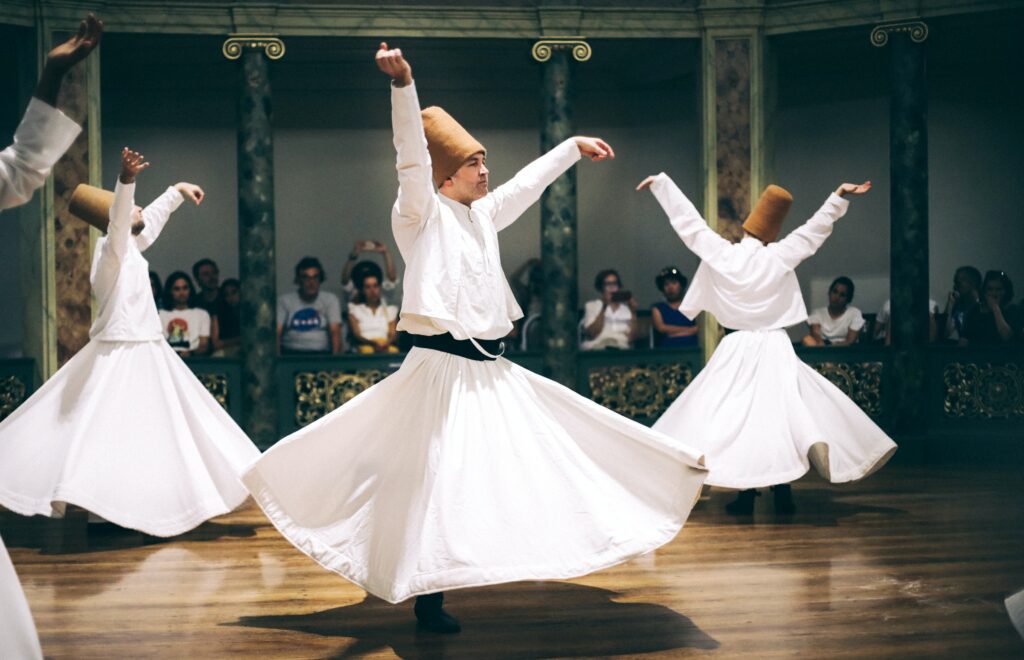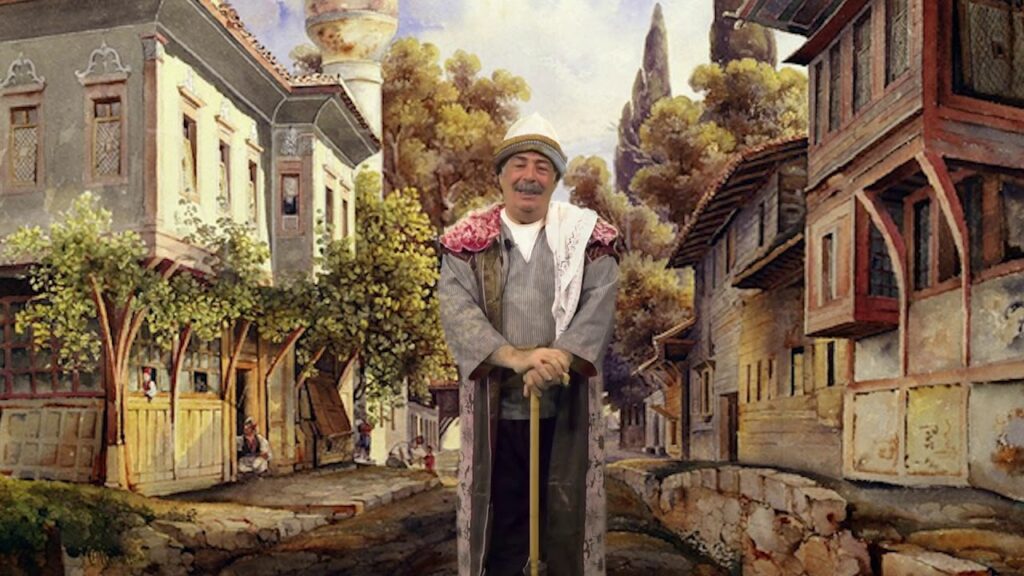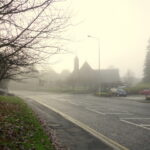Dive into intangible cultural heritage!
Introduction
UNESCO Intangible Cultural Heritage : In 1960, a prominent twentieth-century thinker stated that culture cannot be reduced to concrete items since it is always living and growing. He truly captured the essence of cultural legacy, which is made up of not only tangible things, but also and mainly of the important aspects that symbolize the live culture of human societies, their growth, and ongoing development.
In 2003, UNESCO established a convention to safeguard intangible cultural heritage, too, which includes knowledge and practices, plus the related “objects, artifacts, and cultural spaces” that groups consider part of their cultural heritage and identity. The goal is to help spread awareness in order to preserve these activities, which could be dance or artisanry or even how to make a type of instrument or food.
Here you will find Turkey‘s cultural practices which are accepted as a intangible cultural heritage of UNESCO.
Mevlevi Sema Ceremony (Whirling Dervishes Ceremony)
The Mevleviye is an ascetic Sufi order founded in 1273 in Konya, from where it gradually spread throughout the Ottoman Empire. Today, the Mevleviye can be found in many Turkish communities throughout the world, but the most active and famous centres of the order’s activity are in Konya and Istanbul.

The Mevleviye are renowned for their whirling dances. Following a recommended fast of several hours, the whirlers begin to rotate on their left feet in short twists, using the right foot to drive their bodies around the left foot. The body of the whirler is meant to be supple, with eyes open but unfocused so that images become blurred and flowing. At their dancing ceremonies, or Sema, a particular musical repertoire called ay›n is played. Based on four sections of both vocal and instrumental compositions, it is performed by at least one singer, a flute-player, called neyzen, a kettledrummer and a cymbal player. Dancers used to receive 1,001 days of reclusive training within the mevlevi-houses (mevlevihane), where they learned about ethics, codes of behaviour and beliefs by practising prayer, religious music, poetry and dance. After this training, they remained members of the order but returned to their work and families. As a result of secularization policies, all mevlevihane were closed in 1925.The Turkish government began to allow performances again, though only in public, in the 1950s, restrictions were eased in the 1990s. Some private groups are re-establishing the original spiritual and intimate character of the Sema ceremony. However, over the thirty years the tradition was practised clandestinely, transmission focused rather on music and songs than on spiritual and religious traditions, which has deprived performances of part of their religious significance. Consequently, many sema ceremonies are no longer performed in their traditional context but for tourist audiences, and have been shortened and simplified to meet commercial requirements. Read more Whirling Dervishes Ceremony
Arts of the Meddah, public storytellers

Meddahlik was a Turkish theatre form performed by a single storyteller called a meddah and practised throughout Turkey and Turkishspeaking countries. Through the ages, similar narrative genres have flourished due to interaction among the peoples of Asia, the Caucasus and the Middle East within this wide geographical area.Historically, meddahs were expected to illuminate, educate, and entertain. Performing in caravanserais, markets, coffeehouses, mosques and churches, these storytellers transmitted values and ideas among a predominantly illiterate population. Their social and political criticism regularly provoked lively discussions about contemporary issues. The term meddah, borrowed from Arabic maddah “to praise”, can be translated as “storyteller”. The meddah selects songs and comic tales from a repertory of popular romances, legends and epics and adapts his material according to the specific venue and audience. However, the quality of the performance largely depends on the atmosphere created between storyteller and spectators, as well as the meddah’s ability to integrate imitations, jokes and improvisation often relating to contemporary events. This art, which places great value on the mastery of rhetoric, is highly regarded in Turkey. Although some meddahs still perform at a number of religious and secular celebrations and appear on television shows, the genre has lost much of its original educational and social function due to the development of the mass media and in particular because of the appearance of TV sets in cafés.
Karagöz
Karagöz is a form of shadow theatre in Turkey in which figures known as tasvirs made of camel or ox hide in the shape of people or things are held on rods in front of a light source to cast their shadows onto a cotton screen. A play begins with the projection of an introductory figure to set the scene and suggest the themes of the drama, before it vanishes to the shrill sound of a whistle, giving way to a main performance that may incorporate singing, tambourine music, poetry, myth, tongue-twisters and riddles. The usually comic stories feature the main characters Karagöz and Hacivat and a host of others, including a cabaret chanteuse called Kantocu and an illusionist-acrobat named Hokkabaz, and abound in puns and imitations of regional accents. The puppets are manipulated by one lead artist, the Hayali, who may have one or more apprentice-assistants who are learning the craft by helping to create the tasvirs and accompanying the action with music. Once played widely at coffeehouses, gardens, and public squares, especially during the holy month of Ramazan, as well as during circumcision feasts, Karagöz is found today mostly in performance halls, schools and malls in larger cities where it still draws audiences. The traditional theatre strengthens a sense of cultural identity while bringing people closer together through entertainment.
Âşıklık (minstrelsy) tradition
The Âşıklık (minstrelsy) tradition of Turkey is performed by wandering poet-singers known as âşıks. Dressed in traditional clothes and plucking a stringed saz, the âşık is a common performer at weddings, in coffeehouses and during public festivals of all sorts. The âşık is called in a dream to undertake a long apprenticeship in the arts of playing string and percussion instruments, singing, storytelling and repartee that form the heart of the vocation. The poems they recite, usually about love, are written in rhymed syllabic meter and end with a quatrain in which the âşık utters the Mâhlas, his pseudonym. Their improvisational performances may also include riddles, folk tales, verbal duels of wit and creativity with other âşıks, and verses sung while the minstrel holds a needle in his mouth to force him to recite poems avoiding B, P, V, M and F sounds. Because âşıks travel between communities, they help to spread cultural values and ideas and to facilitate a robust social dialogue, in part through topical poetry and social and political satire. At weddings in particular, âşıks are regarded as instructors and guides whose tradition draws on and enriches Turkish literary culture and the daily lives of communities throughout the country.
Traditional Sohbet meetings
Traditional Sohbet meetings play a crucial role in transmitting Turkish folk literature, folk dances and music, village plays as well as societal values. Turkish men meet regularly indoors, especially in winter, to discuss local social and cultural issues, safeguard traditions, and encourage solidarity, mutual respect and a sense of community. Meetings may include music, dances and plays, all enjoyed while consuming local dishes. A traditional Sohbet meeting may last until the early morning. Meetings are open to men above the age of 15 or 16, regardless of ethnicity, religion or status, with the basic requirement that members be of honest families, be trustworthy and respectful of their elders, and not gamble or display public drunkenness. Members may be penalized with a fine for missing a meeting, except under extenuating circumstances. Mothers and wives encourage male members to attend because of the associated social and cultural benefits. Communities usually comprise five to thirty persons and are guided by leaders, appointed by election or proposed by elders. Members of the community all have equal rights and commitments. The Sohbet meetings fulfil an important educational function by transferring ethical values such as social justice, tolerance, benevolence and respect.
Semah, Alevi-Bektaşi ritual
Semahs can be described as a set of mystical and aesthetic body movements in rhythmic harmony. They constitute one of the twelve main services found in Cem rituals, religious practices performed by adherents of Alevi-Bektaşi, a belief system based on admiration for Ali, the fourth caliph after the prophet Muhammed. Semahs are performed by semahçıs (Semah dancers), accompanied by devout musicians playing the saz long-necked lute. Various forms of Semah exist in Alevi-Bektaşi communities across Turkey, each with distinct musical characteristics and rhythmic structures. One consistent characteristic is the performance of the ritual by both men and women, side by side. Semah rituals are founded upon the concept of unity with God as part of a natural cycle: people come from God and return to God. There are two forms of Semah: İçeri Semahs are performed in Cems only among adherents as part of the twelve services; Dışarı Semahs are performed independent of services to promote Semah culture to younger generations. Semahs are the most crucial means for the transmission of the Alevi-Bektaşi tradition. All practices, traditional motifs and teachings are passed on orally, and distinct genres of art and literature associated with the tradition continue to thrive. In this way, Semahs play a crucial role in fostering and enriching the traditional music culture of Turkey.
Kırkpınar oil wrestling festival
The Kırkpınar oil wrestling festival takes place in Edirne, Turkey. Thousands of people from different age groups, cultures and regions travel every year to see Pehlivan (wrestlers) fight for the Kırkpınar Golden Belt and the title of Chief Pehlivan. Each festival is launched by its patron, the Kırkpınar Aga, in a ceremony featuring forty bands of davul drums and zurna shawms. The golden belt is carried through the city in a procession, followed by prayers recited in the Selimiye Mosque. The wrestling bouts customarily take place at the Men’s Field. The master of ceremonies introduces the Pehlivans to the audience, reciting in verse their names, titles and skills. Next, the oil man oils the wrestlers assisted by the towel holder, before the warm-up exercises and greetings. The wrestlers each wear kıspet, thick trousers made of water buffalo or cow leather. As the wrestling takes place, the drum and shawm bands play the traditional repertoire of the festival. Kırkpınar oil wrestling is open to men from all cultures, regions and ages without discrimination between religion, language or race. Pehlivans are considered exemplary figures in society with attributes such as generosity, honesty, respectfulness and adherence to traditions and customs. All Pehlivans are trained in the master-apprentice tradition.
Ceremonial Keşkek tradition
Keşkek is a traditional Turkish ceremonial dish prepared for wedding ceremonies, circumcisions and religious holidays. Women and men work together to cook wheat and meat called ‘Keşkek’ in huge cauldrons, then serve it to the guests. The wheat is washed with prayers the preceding day, and then carried to a large stone mortar, to the accompaniment of music from the davul drum and zurna double-reed pipe. At the mortar it is hulled by two to four persons using gavels in a fixed rhythm. Cooking is usually carried out outdoors: hulled wheat, chunks of meat on the bone, onions, spices, water and oil are added to the cauldron and cooked all night. Towards noon, the strongest of the village youth are called to beat the Keşkek with wooden mallets, while the crowd cheers and zurna players perform musical pieces, announcing the thickening of the stew with a specific melody. Numerous expressions associated with the dish – used during the selection of wheat, the blessings, praying and carrying the wheat, as well as preparing and cooking it – have become common expressions in daily life. In addition, the tradition encompasses entertainment, plays and musical performances. Neighboring towns and villages are invited to feast collectively in the ceremony premises. The cooking tradition is safeguarded and transmitted by master cooks to apprentices.
Mesir Macunu Festival
The Mesir Macunu festival of Manisa, Turkey, commemorates the recovery of Hafsa Sultan, mother of Suleiman the Magnificent, who was cured of a disease by the invention of a paste known as mesir macunu. The Sultan then ordered that the paste be disseminated to the public. So, every year from 21 to 24 March, the paste is prepared by a chef and apprentices from 41 fresh spices and herbs according to traditional practice. A team of 14 women wrap the paste in small pieces of paper, and 28 imams and apprentices bless it before scattering the paste from the top of the minaret and the domes of the Sultan Mosque. Thousands of people come from different regions of Turkey to compete to catch the pieces as they fall. Many believe that by so doing their wishes for marriage, work and children will come true within a year. A 45-piece orchestra dressed in traditional clothing perform historical Ottoman music during the preparation of the paste and throughout the festival. Inhabitants of Manisa have a deep emotional attachment to the festival. The strength of tradition creates a strong sense of solidarity among local communities, and the city welcomes guests from almost all regions of Turkey.
Turkish coffee culture and tradition
Turkish coffee combines special preparation and brewing techniques with a rich communal traditional culture. The freshly roasted beans are ground to a fine powder; then the ground coffee, cold water and sugar are added to a coffee pot and brewed slowly on a stove to produce the desired foam. The beverage is served in small cups, accompanied by a glass of water, and is mainly drunk in coffee-houses where people meet to converse, share news and read books. The tradition itself is a symbol of hospitality, friendship, refinement and entertainment that permeates all walks of life. An invitation for coffee among friends provides an opportunity for intimate talk and the sharing of daily concerns. Turkish coffee also plays an important role on social occasions such as engagement ceremonies and holidays; its knowledge and rituals are transmitted informally by family members through observation and participation. The grounds left in the empty cup are often used to tell a person’s fortune. Turkish coffee is regarded as part of Turkish cultural heritage: it is celebrated in literature and songs, and is an indispensable part of ceremonial occasions. Read more on Turkish Coffee Culture
Ebru, Turkish art of marbling
Ebru is the traditional Turkish art of creating colorful patterns by sprinkling and brushing colour pigments onto a pan of oily water and then transferring the patterns to paper. Known as marbling, the designs and effects include flowers, foliage, ornamentation, latticework, mosques and moons, and are used for decoration in the traditional art of bookbinding. The practitioner uses natural methods to extract colors from natural pigments, which are then mixed with a few drops of ox-gall, a kind of natural acid, before sprinkling and brushing the colors onto a preparation of condensed liquid, where they float and form swirling patterns. Ebru artists, apprentices and practitioners consider their art to be an integral part of their traditional culture, identity and lifestyle. Their knowledge and skills, as well as the philosophy behind this art, are transmitted orally and through informal practical training within master-apprentice relationships. Achieving basic skills in Ebru takes at least two years. The tradition is practiced without barrier of age, gender or ethnicity, and plays a significant role in the empowerment of women and the improvement of community relationships. The collective art of Ebru encourages dialogue through friendly conversation, reinforces social ties and strengthens relations between individuals and communities.
Traditional craftsmanship of Çini-making
Çini are traditional, handmade glazed tiles and ceramics made in Turkey featuring colorful motifs of plants, animals and geometric patterns often found on facades of buildings and in homes throughout the country. Producing çini involves a series of processes. The clay is first shaped, lined, dried and fired in ovens specifically for çini making. Designs representing local customs and beliefs are then drilled on paper and transferred to the surface with coal dust. Outer contours of the patterns are hand drawn, the surface dyed in various colors and then the work is glazed and fired. Çini-making workshops involve craftspeople, supervisors and apprentices. Each craftsperson has a specific role – shaping, design and dye, polishing and undercoating or firing. Practitioners consider çini making as an outlet for self-expression, development and healing, as well as a means of maintaining an art form that is a symbolic aspect of Turkey’s cultural identity, strengthening links from the past to the present providing continuity. Çini making is not confined to workshop spaces. The tradition is also practiced in the home, public education centres, vocation schools and universities throughout the country where neither age, gender nor ethnicity are barriers to knowledge sharing, transmission and skills development.
Nevruz
New Year is often a time when people wish for prosperity and new beginnings. March 21 marks the start of the year in Afghanistan, Azerbaijan, India, Iran (Islamic Republic of), Iraq, Kazakhstan, Kyrgyzstan, Pakistan, Tajikistan, Turkey, Turkmenistan and Uzbekistan. It is referred to as Nauryz, Navruz, Nawrouz, Nevruz, Nooruz, Novruz, Nowrouz or Nowruz meaning ‘new day’ when a variety of rituals, ceremonies and other cultural events take place for a period of about two weeks. An important tradition practised during this time is the gathering around ‘the Table’, decorated with objects that symbolize purity, brightness, livelihood and wealth, to enjoy a special meal with loved ones. New clothes are worn and visits made to relatives, particularly the elderly and neighbors. Gifts are exchanged, especially for children, featuring objects made by artisans. There are also street performances of music and dance, public rituals involving water and fire, traditional sports and the making of handicrafts. These practices support cultural diversity and tolerance and contribute to building community solidarity and peace. They are transmitted from older to younger generations through observation and participation.
Flatbread making and sharing culture: Lavash, Katyrma, Jupka, Yufka
The culture of making and sharing flatbread in communities of Azerbaijan, Iran, Kazakhstan, Kyrgyzstan and Turkey carries social functions that have enabled it to continue as a widely-practised tradition. Making the bread (lavash, katyrma, jupka or yufka) involves at least three people, often family members, with each having a role in its preparation and baking. In rural areas, neighbors participate in the process together. Traditional bakeries also make the bread. It is baked using a tandyr/tanūr (an earth or stone oven in the ground), sāj (a metal plate) or kazan (a cauldron). Besides regular meals, flatbread is shared at weddings, births, funerals, various holidays and during prayers. In Azerbaijan and Iran, it is put on the bride’s shoulders or crumbled over her head to wish the couple prosperity while in Turkey it is given to the couple’s neighbors. At funerals in Kazakhstan it is believed the bread should be prepared to protect the deceased while a decision is made from God and in Kyrgyzstan sharing the bread provides a better afterlife for the deceased. The practice, transmitted by participation within families and from master to apprentice, expresses hospitality, solidarity and certain beliefs that symbolize common cultural roots reinforcing community belonging.
Spring celebration, Hıdrellez
The Spring Celebration ‘Hidrellez’ takes place annually on 6 May, which is recognized as Spring Day, or the awakening of nature. ‘Hidrellez’ is a compound noun derived from ‘Hidir’ and ‘Ilyas’, which are believed to be the protectors of earth and water and the helpers of individuals, families and communities in need of them. To mark this occasion, various ceremonies and rituals connected with nature are performed, guaranteeing the wellbeing, fertility and prosperity of the family and community and protecting livestock and crops for the upcoming year. The element belongs to all participants: families, children, youth, adults, dancers and singers. The rituals have deep-rooted cultural meanings and provide the community with a sense of belonging and cultural identity and an opportunity to strengthen relations. The communities concerned ensure the viability of the element by participating in the Spring Celebration on an annual basis. The complex organization of related events at the local, regional and national levels ensures the wide participation of individuals, groups and communities. The element is recognized as a key part of the cultural identity of the local communities and related knowledge and skills are transmitted within the family and between community members through oral communication, observation, participation and performances.
Whistled language
Whistled language is a method of communication that uses whistling to simulate and articulate words. The practice developed as a result of the steep mountains and rugged topography of the region, which required the local population to find an alternative way to communicate across long distances. The practitioners are mainly agricultural communities who spend most of their lives outdoors. The communities concerned consider this practice to be a key reflection of their cultural identity, which reinforces interpersonal communication and solidarity. Although the community is aware of the importance of this practice, technological developments and socioeconomic changes have led to a decline in the number of practitioners and areas where it is spoken. One of the key threats to the practice is the use of mobile phones. The new generation’s interest in whistled language has diminished considerably and there is a risk that the element will be gradually torn from its natural environment, becoming an artificial practice. In spite of such threats, the communities have been actively promoting this linguistic practice both nationally and internationally to ensure its sustainability, and whistled language is still transmitted from generation to generation in the context of parent-child relations through both formal and informal methods.
Heritage of Dede Korkut, epic culture, folk tales and music
The epic culture, folk tales and music of Dede Qorqud/Korkyt Ata/Dede Korkut are based on twelve heroic legends, stories and tales and thirteen traditional musical compositions shared and transmitted across the generations through oral expressions, performing arts, cultural codes and musical compositions. Dede Qorqud appears in each story as a legendary figure and wise individual, a sage of minstrels whose words, music and expressions of wisdom relate to traditions of birth, marriage and death. In the musical compositions, the main intonations are reproduced using a musical instrument called the Kobyz through the sounds of nature, and imitation soundscapes are characteristic of this medium (such as the imitation of a wolf’s howl or a swan’s note). The musical compositions are all interconnected by the epic stories that accompany them. The element encompasses social, cultural and moral values such as heroism, dialogue, physical and spiritual wellness and unity as well as respect for nature, and contains profound knowledge about the history and culture of Turkic-speaking communities. It is practiced and sustained by the community concerned on a wide variety of occasions – from family events to national and international festivals – and is therefore well-rooted in society, serving as a connecting thread between generations.
Traditional Turkish archery
Traditional Turkish archery encompasses principles, rituals and social practices, the craftsmanship of traditional equipment, archery disciplines and shooting techniques that have evolved over the centuries. In traditional Turkish archery, there are different types of disciplines practiced on foot and horseback. Bearers and practitioners train individually or collectively to improve their skills, carry out individual shootings and take part in competitions and festive events. The craftsmanship of traditional archery equipment is a key component of the element. The equipment is made with raw materials such as trees grown under certain climatic conditions at high altitudes, organic glues, horns, tendons, silk and leather. Craftspeople must therefore have advanced knowledge of nature, including plants, animals and the climate. Archery equipment is generally decorated with calligraphy, ornaments and marquetry. Craftspeople engaged in the craftsmanship of traditional archery equipment also play an important role in safeguarding the element, with the related skills being transmitted from master to apprentice or through self-learning. In recent years, there has been a remarkable increase in the number of female archers and trainees, as well as a significant increase in the number of non-governmental organizations involved in archery in various regions of Turkey. Bearers and practitioners ensure the continued viability of the element by adopting it to fit contemporary conditions.
Traditional intelligence and strategy game: Mangala/Göçürme
Togyzqumalaq, Toguz Korgool, Mangala/Göçürme is a traditional game which can be played on special boards or improvised ones such as pits on the ground. The game can be played with pellets made of stone, wood, metal and bone, nuts, or seeds, which are distributed across the pits; the player who gathers the most pellets wins the game. There are several variations of the game. For example, the board can have two, three, four, six or nine pits arranged in order according to the number of players, and the duration varies according to the number of players. In the submitting States, the element is linked to other traditional crafts such as wood and stone carving and jewelry making. Wood and stone carving masters and jewelers make elaborately decorated boards and pellets as well as practical ones, reflecting traditional worldviews and their artistic creativity. The game improves players’ cognitive, motor and social skills and strategic and creative thinking, and teaches them to be patient and considerate. It is transmitted both informally and through formal education. Recently, the communities concerned have also developed mobile device applications for learning and/or playing the game, which provide a new way of transmitting related skills and increasing the visibility of the practice among younger generations.










